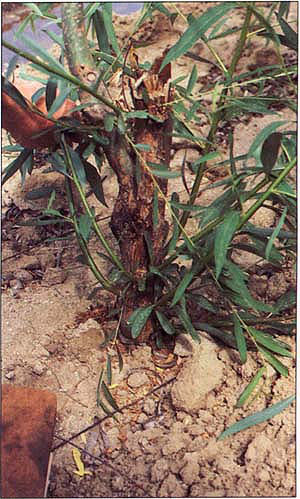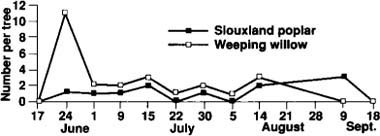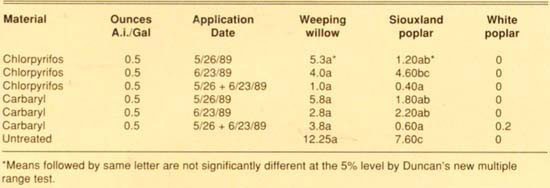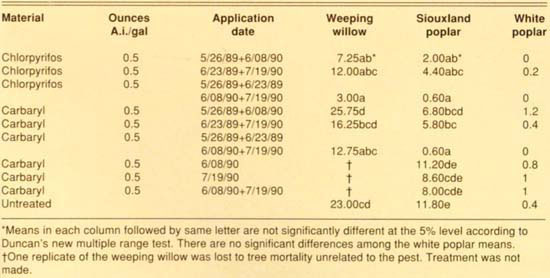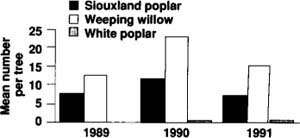All Issues
On some tree species, annual sprays may control western poplar clearwing moth
Publication Information
California Agriculture 48(4):37-40.
Published July 01, 1994
PDF | Citation | Permissions
Abstract
The western poplar clearwing moth, a serious pest to many species of western ornamental trees, can cause limb breakage or tree death in severe cases. In a study of three'species of ornamentals, the moth's development and infestation levels were measured in trees treated with carbaryl or chlorpyrifos. In heavily infested trees, annual insecticide applications provided control.
Full text
The western poplar clearwing moth, Paranthrene robiniae, is a serious pest of many species of ornamental trees in California, Nevada and Washington. In the San Joaquin Valley, the moth commonly infests willows, Salix spp., cottonwood and poplar, Populus spp., and white birch, Betula spp.
Larval infestation can break limbs and, in severely infested trees, cause death. The western poplar clearwing moth is particularly a problem when it invades nurseries, which offer the pest a wide range of hosts. One nursery reported destroying 15% of their poplar trees, which were infested with the moth, to prevent customer complaints and distribution of the pest to new locations.
Infestation exhibits various symptoms. Shortly after the larva enters the wood, the limb swells until it resembles an enlarged twig gall. In the first or second year after the attack, just before moth emergence, the larva will push frass to the outside of its tunnel. This frass will hang loosely from the opening of the exit hole. Then just before emerging, the pupa will push itself out of the exit hole head first and remain exposed for a short period of time. The adult will emerge from the pupal case, leaving the exuvium in the exit hole. These cast-off pupal cases can be used to detect the progression of moth emergence during the year.
Despite the common appearance of this moth throughout California, little is known about its biology and control. This study was initiated in 1989 to develop information about host susceptibility, adult moth emergence patterns and the efficacy of insecticides for control.
Three tree species planted
In February 1989, 50 trees each of Populus alba (white poplar), Populus canadensis ‘Siouxland’ (Siouxland poplar) and Salix babylonica (weeping willow) were planted at an isolated site 2 miles south of Wasco, California. The trees had been grown in a nursery from short cuttings in 1988. Each species was planted at 4-foot intervals in rows within 30 feet of one another. There were no other hosts within 1/2 mile of the planting.
Above, larval infestation can break limbs and, in severely infested trees such as the weeping willow shown here, cause death.
Below, shortly after the western poplar clearwing moth larva enters the wood, the limb swells until it resembles an enlarged twig gall.
During April 1989, branches from a known infestation in hybrid poplar trees at California State University, Bakersfield, were examined periodically to detect the progression of larval development. Three Pherocon lc sticky traps baited with the synthetic pheromone for Paranthrene simulans were placed in early May 1989 at the Cal State site in the hope of detecting the emergence of male moths; however, no moths were trapped during the season. Large larvae and a single pupa were seen on May 1, at which time bolts with larval swells — indicating infestation by the western poplar clearwing moth — were cut, transported and distributed all over the test plot area at Wasco. Mature larvae were detected in samples from these bolts on May 15. On May 22 moths had begun to emerge from the wood.
Moth emergence in the Wasco test plot was traced in 1990 and 1991 by counting, on a 7- to 14-day basis, the empty pupal cases on the untreated trees for each of the three species. In 1990 moth emergence was first detected on June 4; during that year moths emerged from only the Siouxland poplar. In 1991 moth emergence was first detected on June 24; it occurred in both the Siouxland poplar and the weeping willow. A completely randomized design was used to compare the total number of moths that had emerged from the untreated trees of the three species during 1990 and 1991.
The insecticide study was designed so that some of the trees would be treated in both 1989 and 1990, some would not be treated in 1989 but would receive treatments in 1990, and a third group of trees would remain untreated. A randomized, complete-block design was used. Plots were single trees, with five replicates per treatment on each of the three species. All three tree species were initially 8 to 10 feet high, with little limb branching. The two insecticides evaluated were carbaryl (Sevin 80S) and chlorpyrifos (Dursban 4E). Only the Dursban is currently registered for this use. The rate of the carbaryl was 0.0375 pounds per 1 gallon of mix; the rate of the chlorpyrifos was 0.03 quarts per 1 gallon of mix. These rates were chosen so that there would be an equivalent 3 pounds active ingredient per 100 gallons of either material.
For the first group of trees, treated in both 1989 and 1990, either carbaryl or chlorpyrifos insecticide was applied as an early summer spray, a midsummer spray or a combination of early summer and midsummer sprays. In 1990, trees not sprayed in 1989 were treated with carbaryl as an early summer spray, a midsummer spray or a combination of early and midsummer sprays. This design resulted in 10 treatments over the 2-year period.
In 1989 the insecticides were applied with a Hudson sprayer to the point of runoff on May 26 and June 23. On May 26 the carbaryl-treated trees received an average of 8.5 fluid ounces of spray per tree, and the chlorpyrifostreated trees received an average of 10.7 fluid ounces per tree. On June 23, both the carbaryl and chlorpyrifos treated trees received 8.5 fluid ounces of spray per tree.
In 1990 sprays were applied with a Bean high-pressure sprayer at 180 psi on June 7 and on July 19. The Siouxland poplar and the white poplar were 12 to 15 feet and the weeping willow 10 feet in height, all with profuse branching. Again, the sprays were applied to the point of runoff and in the same concentration as in the previous year. One replicate of the weeping willow was lost to tree mortality unrelated to the pest. Therefore, only four replicates of the weeping willow were evaluated, and carbaryl treatments scheduled to be applied in 1990 only were not made to that species.
Infestation was measured by counting active larval tunnels between ground level and 9 feet high. The counts were made on August 22, 1989, and on December 11, 1990. Also at that time, trunk circumference was measured 6 inches above ground. Counts and measurements were subjected to an analysis of variance.
Emergence study results
The western poplar clearwing moth began to emerge from the Siouxland trees on June 4, 1990, and continued to emerge through September, with the last empty pupal cases counted on October 5 (fig. 1). The bulk of the moths, 64%, emerged during June and July. No emergence was noted from the weeping willow, which had severe larval infestation, or from the white poplar, which had no evidence of infestation.
In 1991 only 11 moths emerged from the Siouxland poplar and 25 from the weeping willow. First emergence was noted for both species on June 24; emergence continued through September 9 (fig. 2). By July 30, 84% of the moths in the weeping willow and 55% of the moths in the Siouxland poplar had emerged. The emergence was much less than expected and may have been delayed by the record freeze of December 1990. No emergence was detected in the white poplar.
Insecticide trial results
In 1989 the number of active tunnels was significantly reduced in the Siouxland poplar that had been treated with two applications of chlorpyrifos or carbaryl (table 1). The May 26 spray of chlorpyrifos, the May 26 spray of carbaryl and the June 23 spray of carbaryl yielded results that were not significantly different from were not significantly different from those of the double sprays.
Although the weeping willow infestation was similar to that in the Siouxland poplar, the variability in the untreated controls was quite high, and the sprays were found to have had no significant effect. Only one infestation was found in the white poplar.
Differences in infestation levels were apparent in 1990, following 2 years of treatment in both the Siouxland poplar and the weeping willow (table 2). The infestation in the white poplar remained too low to discern treatment differences.
For Siouxland poplar, the double applications of either chlorpyrifos or carbaryl applied in both 1989 and 1990 resulted in fewer larvae, but the numbers were not significantly different from those achieved with either single chlorpyrifos spray. The effect of single sprays of carbaryl applied in both 1989 and 1990 were similar to the chlorpyrifos single sprays, but they were not as effective as the double applications of chlorpyrifos. However, trees treated with any of these sprays had lower wpcm infestations than the untreated controls. The infestation levels in trees treated with the carbaryl single sprays in 1990 only and the combination of an early and midsummer spray in 1990 were no different from the levels in the untreated control trees, possibly reflecting the emergence of adults from eggs that had been laid the previous year.
TABLE 1. Average number of active moth larval sites per tree on the trunks of three ornamental species, August 22, 1989
TABLE 2. Average number of active worm larval sites per tree on the trunks of three species of ornamentals, December 11, 1990
On the weeping willow, carbaryl was clearly not as effective as chlorpyrifos. This difference may be due to the willow's rough deep bark, which makes a soluble powder formulation less effective than an emulsifiable concentrate such as chlorpyrifos. A true solution, in a solvent, would be absorbed into the bark better than a suspension and provide longer control. A double spray of chlorpyrifos in both 1989 and 1990 resulted in the lowest levels of infestation.
In comparisons of the infestation levels in the untreated controls of the three species, each species was found to differ significantly from the others (fig. 3). The least infested was the white poplar, followed by the Siouxland poplar and the weeping willow. Tree death, which was recorded in a number of weeping willow, appeared to be the direct result of infestation by the western poplar clearwing larvae. The larvae did not cause tree death in either of the other species.
Fig. 3. Average number of active wpcm larval holes per untreated tree. Means are significantly different between tree species within each year, P<0.05 for 1990 and 1991, P<0.06 for 1989 by Duncan's new multiple range test.
Trunk circumference measurements of all three tree species were taken to determine how infestation affected growth. The measurements revealed no differences that could be correlated with the spray treatments received.
Damage depends on species
The western poplar clearwing moth has a prolonged period of emergence from poplar and weeping willow, extending from June through September. Larval development in weeping willow required 2 years. On Siouxland poplar, some individuals developed within 1 year, indicating that poplar is more suitable for this insect's growth.
Infestation by western poplar clearwing moth was more severe on some hosts than others, indicating that a wise choice of species can lessen the severity of this pest. The most severely damaged species in this study was weeping willow, followed by Siouxland poplar. In areas where the moth is common, weeping willow and Siouxland poplar should therefore not be planted unless growers are willing to apply residual insecticides for control. White poplar was almost undamaged and may not require chemical control.
Above right, the western poplar clearwing moth, Paranthrene robiniae, is a serious pest of many species of ornamental trees in California, Nevada and Washington.
Below right, the adult will emerge from the pupal case, leaving the exuvium in the exit hole. These cast-off pupal cases can be used to detect the progression of moth emergence during the year.
Although the moth can be controlled with insecticides, severely infested hosts such as weeping willow would probably require yearly treatment. The long period of moth emergence would make chemical control with a single spray difficult. However, applications in June or July could be expected to reduce attacks by more than 50%. In this study, the most consistent control was given by chlorpyrifos. Trees receiving double applications each year consistently suffered less wpcm damage than the untreated control. Single applications in both 1989 and 1990 also reduced infestation.
Two applications of carbaryl each year were successful in reducing infestation in the Siouxland poplar only. In the weeping willow, the applications of carbaryl did not significantly reduce infestation.



